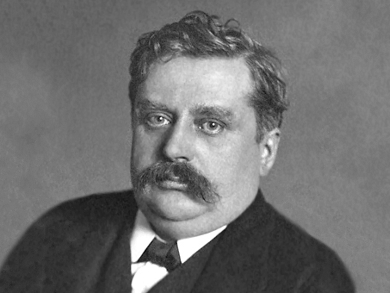Alfred Werner was born in Mülhausen in Alsace, today’s France, on December 12, 1866. He developed an early interest in chemistry and set up a makeshift laboratory in his father’s barn. At the age of 18, he had already completed his first independent chemical investigations. In 1885, Werner moved to Karlsruhe, Germany, for one year of military service and started to study chemistry at the Institute of Technology there.
After his military service, Werner continued his studies at the Swiss Federal Institute of Technology (ETH) Zurich, Switzerland. He received his diploma in technical chemistry in 1889 and his Ph.D. in chemistry in 1890. He then spent one semester at the Collége de France in Paris, working with Marcellin Berthelot, before returning to Zurich. Werner was appointed Assistant Professor at the University of Zurich in 1893, at only 27 years of age. He was promoted to Full Professor two years later, became a Swiss citizen that same year, and remained in Zurich for the rest of his career.
Werner’s early research focused on organic chemistry. His doctorate thesis explained the stereoisomers of oximes, which exist in cis and trans forms. This laid the foundations for the stereochemistry of nitrogen. His most notable achievement, however, was creating the basis of inorganic coordination chemistry.
Before Werner’s work, researchers had struggled to fit metal complexes into the bounds of Kekulé’s valence theory. Werner’s hypothesis was that central metal atoms or ions are surrounded by other atoms or molecules (ligands) in simple geometric arrangements. He developed the concept of the coordination number and postulated an octahedral configuration for complexes with the coordination number six. This breakthrough concept explained the properties of existing coordination compounds and also predicted entire series of new compounds.
At the time of this discovery in 1892, Werner had not performed experimental work on the subject. According to him, the idea came to him in a stroke of insight in the middle of the night. Over the next two decades, Werner and his students synthesized a vast number of inorganic complexes and substantiated his hypothesis. In 1913, Werner received an unshared Nobel Prize in Chemistry “in recognition of his work on the linkage of atoms in molecules by which he has thrown new light on earlier investigations and opened up new fields of research especially in inorganic chemistry”. He was the first inorganic chemist and the first Swiss chemist to win a Nobel Prize in Chemistry.
Alfred Werner died on November 15, 1919. His impact on inorganic chemistry, however, lived on: In 2001, 82 years after his death, Werner was listed as co-author of a peer-reviewed paper [1]. The researchers had used crystal samples prepared by him and preserved at the University of Zurich. Every year, the Swiss Chemical Society (SCS) honors promising young scientists with the Werner Prize.
Alfred Werner is the answer to Guess the Chemist (60).
References
- [1] Crystal Structure Determination of a (μ-Amido)(μ-hydroxo)(μ-superoxo)dicobalt(III) Complex from the Werner Collection,
B. Spingler, M. Scanavy-Grigorieff, A. Werner, H. Berke, S. J. Lippard,
Inorg. Chem. 2001, 40, 1065–1066.
DOI: 10.1021/ic001137t
Sources
- Alfred Werner,
G. B. Kauffman,
Encyclopædia Britannica 2007. - Alfred Werners Koordinationstheorie: “Eine geniale Frechheit” (in German),
L. H. Gade,
Chem. Unserer Zeit 2002, 36, 168–175.
DOI: 10.1002/1521-3781(200206)36:3<168::AID-CIUZ168>3.0.CO;2-3 - Alfred Werner – Biographical,
in Nobel Lectures, Chemistry 1901–1921, Elsevier Publishing Company, Amsterdam, 1966. - Alfred Werner,
Paul Pfeiffer,
J. Chem. Educ. 1928, 5, 1090–1098.
DOI: 10.1021/ed005p1090 - Alfred Werner (Obituary),
P. Karrer,
Helv. Chim. Acta 1920, 3, 196–224.
DOI: 10.1002/hlca.19200030118
Selected Publications by Alfred Werner
- Lehrbuch der Stereochemie (in German),
A. Werner,
Fischer, Jena, 1904. - Beitrag zur Konstitution anorganischer Verbindungen (in German),
A. Werner,
Z. Anorg. Chem. 1893, 3, 267–330.
DOI: 10.1002/zaac.1893003013 - Beiträge zur Theorie der Affinität und Valenz (in German),
A. Werner,
Zürcher & Furrer, Zurich, 1891.
Also of Interest
- 120 Years of Top Inorganic Chemistry – Alfred Werner,
ChemistryViews.org 2012.
Alfred Werner’s work on the spatial arrangements of atoms in inorganic complexes is celebrated as part of ZAAC’s 120th anniversary - Alfred Werner, der Vater der Komplexchemie, publiziert 2001 in “Inorganic Chemistry” (in German),
Ekkehard Diemann, Achim Müller,
Chem. Unserer Zeit 2002, 36, 80–81.
DOI: 10.1002/1521-3781(200204)36:2<80::AID-CIUZ80>3.0.CO;2-7



